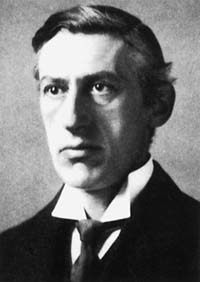
Norman Collie (Courtesy Whyte Museum, V497 PA51-17)
J. Norman Collie
(1859-1942) The view from the Chateau Lake Louise is dominated by Mount Victoria and Mount Lefroy, both of which were first climbed by parties that included this distinguished scientist, explorer, mountaineer, writer, photographer, and art collector. Norman Collie was clearly the epitome of the "Victorian Gentleman" of the late nineteenth century. Born in 1859, Collie began his climbing career on the Isle of Skye, later making first ascents in the Alps and Caucasus and climbing with a British expedition in the Himalayas. In 1897, when he accepted Professor Charles Fay 's invitation to join the Appalachian Club for a summer of climbing in the Canadian Rockies, he was a professor of chemistry as well as one of the most highly regarded British mountaineers with extensive experience in the Alps and the Himalaya. The previous year Charles Fay had been one of four Appalachian Club members attempting Mount Lefroy when the first climbing fatality in the Canadian Rockies occurred resulting in the death of Philip Abbot. Abbot's father had asked Professor Fay to make arrangements for a "Memorial Climb" the following year. The Alpine Club of London was asked to participate and Norman Collie and H.B. Dixon, together with guide Peter Sarbach, joined Fay's party. Exactly one year after the accident the party reached the summit. After a day's rest, Collie and Sarbach led the party that made the first ascent of Mount Victoria. Their route included traversing the mountain's long arete (the summit ridge), which is seen from the Chateau, to the southern and highest summit. Collie then travelled north of Lake Louise with a party that included Charles Fay, Charles S. Thompson, and Peter Sarbach with the hope of climbing Mount Balfour. From a camp on Bow Lake they succeeded in reaching the Wapta Icefield and completed the first ascent of Mount Gordon. From its summit the trio named Mount Collie, Mount Baker, and Mount Thompson. Shortly afterwards, while proceeding towards another summit one third of a mile to the west, Thompson fell through a snowbridge into a crevasse. Collie was lowered by a rope and it with some difficulty Thompson was brought back to the surface of the Icefield. The expedition then returned to Laggan Station below Lake Louise. Collie then set out again on a second trip up the Bow Valley. This time they travelled across Bow Pass and down the Mistaya Valley to Saskatchewan River Crossing. From there they climbed Mount Sarbach, attempted Mount Forbes before retreating in a snowstorm and spent two days exploring the Freshfield Icefield during which they climbed high on Mount Freshfield from which a survey was conducted.. They then travelled across Howse Pass, descended the Blaeberry River to Ensign Creek from which they reached Amiskwi Pass and descended the Amiskwi River to Field. This was a seventeen day trip. Collie returned to the Canadian Rockies the following year (1898). together with Hugh Stutfield and Herman Woolley journeyed to Saskatchewan River Crossing via Pipestone Pass this time, ascending the North Saskatchewan to reach Sunwapta Pass. Woolley and Collie completed the first ascent of Mount Athabasca and from the summit were the first to see the Columbia Icefields. Following a summer of climbing in the Alps, Collie explored in the Rockies again in 1900, this time from the Columbia River. During his 36 days on the trail, the party was dogged by deadfall, thick underbrush, bad weather, and mosquitoes his party made only limited headway towards his objectives of reaching the big peaks near the Columbia icefield from the Columbia Valley. He did, however, complete the first ascent of Mount Edith near Banff together with his outfitter, Fred Stephens. In 1902 Collie returned to the Canadian Rockies again. He participated in five first ascents in North Saskatchewan Headwaters -Mount Murchison, Mount Freshfield, Mount Forbes, Howse Peak, and Mount Noyes. Collie then visited the Valley of the Ten Peaks where he completed in the first ascent of Neptuak Mountain. In 1903, Collie, together with his companion Hugh Stutfield, co-authored "Climbs and Exploration in the Canadian Rockies", a book which is now considered to be a classic in literature related to the Rocky Mountains. Together with A.L. Mumm (see Mumm Peak), Collie visited the Rockies again in 1910 and 1911, exploring the northern sections of what is now Jasper National Park and the Mount Robson area. In 1911, he completed his twenty-first first ascent in the Canadian Rockies. Being the first to explore much of the Rockies, he took the opportunity to name in excess of thirty peaks. One of them was Mount Collie which lies on the western edge of the Wapta Icefield in the northern portion of Yoho National Park. Academically Norman Collie was extremely successful, both a respected teacher and researcher. He completed important work in organic chemistry and did extensive research in other fields of chemistry which resulted in the first fluorescent light and the taking of the first x-ray for medical diagnostic purposes. The recipient of numerous awards and honourary degrees, Dr. Collie was described as "one of the leading lights of science in England." His biographer, Dr. William Taylor, summarized Collie as, "a fascinating character who excelled at science, mountaineering, exploration, geography, photography, art, and whatever else he turned his hand to." As well as Mount Collie in the Canadian Rockies, Sgurr Thormaid (Norman's Peak), on the Isle of Skye, is named after him. [Additional Information: Collie, J. Norman, Hugh Stutfield. "Climbs and Explorations in the Canadian Rockies". London: Longmans, Green, and Co. 1903] [Additional Information: Taylor, William C. "The Snows of Yesteryear". Toronto: Holt Rinehart Winston, 1973]